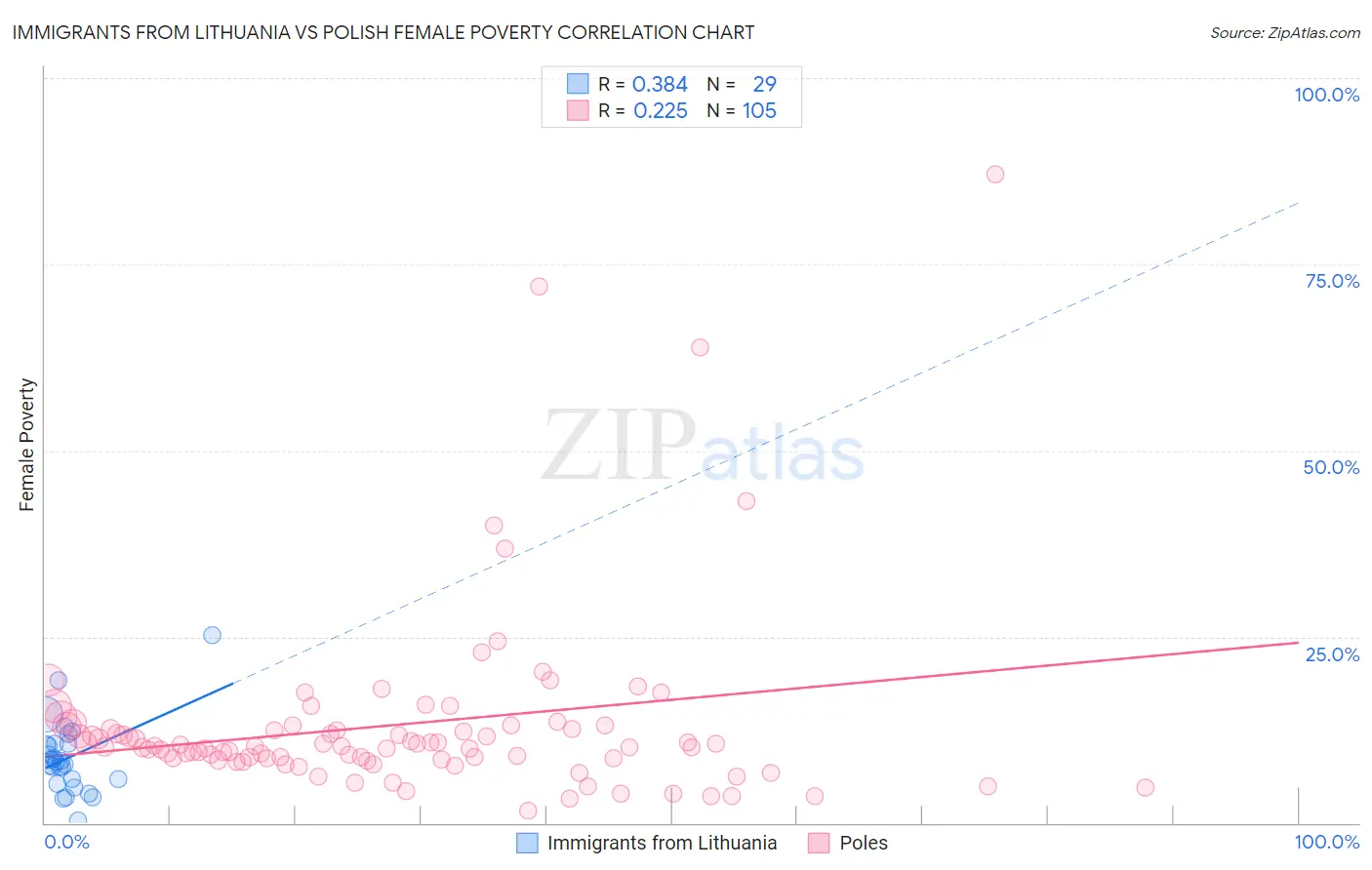Immigrants from Lithuania vs Polish Female Poverty
COMPARE
Immigrants from Lithuania
Polish
Female Poverty
Female Poverty Comparison
Immigrants from Lithuania
Poles
11.3%
FEMALE POVERTY
99.9/ 100
METRIC RATING
13th/ 347
METRIC RANK
11.7%
FEMALE POVERTY
99.5/ 100
METRIC RATING
31st/ 347
METRIC RANK
Immigrants from Lithuania vs Polish Female Poverty Correlation Chart
The statistical analysis conducted on geographies consisting of 117,711,686 people shows a mild positive correlation between the proportion of Immigrants from Lithuania and poverty level among females in the United States with a correlation coefficient (R) of 0.384 and weighted average of 11.3%. Similarly, the statistical analysis conducted on geographies consisting of 559,323,396 people shows a weak positive correlation between the proportion of Poles and poverty level among females in the United States with a correlation coefficient (R) of 0.225 and weighted average of 11.7%, a difference of 3.9%.

Female Poverty Correlation Summary
| Measurement | Immigrants from Lithuania | Polish |
| Minimum | 0.39% | 1.6% |
| Maximum | 25.2% | 87.1% |
| Range | 24.8% | 85.5% |
| Mean | 8.8% | 13.1% |
| Median | 8.3% | 10.3% |
| Interquartile 25% (IQ1) | 5.5% | 8.6% |
| Interquartile 75% (IQ3) | 10.6% | 12.8% |
| Interquartile Range (IQR) | 5.1% | 4.3% |
| Standard Deviation (Sample) | 5.0% | 12.4% |
| Standard Deviation (Population) | 4.9% | 12.4% |
Demographics Similar to Immigrants from Lithuania and Poles by Female Poverty
In terms of female poverty, the demographic groups most similar to Immigrants from Lithuania are Bhutanese (11.3%, a difference of 0.010%), Lithuanian (11.4%, a difference of 0.96%), Latvian (11.4%, a difference of 1.3%), Immigrants from Bolivia (11.5%, a difference of 1.8%), and Bolivian (11.5%, a difference of 1.8%). Similarly, the demographic groups most similar to Poles are Danish (11.7%, a difference of 0.13%), Greek (11.7%, a difference of 0.22%), Immigrants from North Macedonia (11.7%, a difference of 0.30%), Immigrants from Korea (11.7%, a difference of 0.45%), and Iranian (11.7%, a difference of 0.66%).
| Demographics | Rating | Rank | Female Poverty |
| Bhutanese | 99.9 /100 | #12 | Exceptional 11.3% |
| Immigrants | Lithuania | 99.9 /100 | #13 | Exceptional 11.3% |
| Lithuanians | 99.8 /100 | #14 | Exceptional 11.4% |
| Latvians | 99.8 /100 | #15 | Exceptional 11.4% |
| Immigrants | Bolivia | 99.8 /100 | #16 | Exceptional 11.5% |
| Bolivians | 99.8 /100 | #17 | Exceptional 11.5% |
| Immigrants | Scotland | 99.8 /100 | #18 | Exceptional 11.5% |
| Norwegians | 99.8 /100 | #19 | Exceptional 11.5% |
| Eastern Europeans | 99.7 /100 | #20 | Exceptional 11.5% |
| Italians | 99.7 /100 | #21 | Exceptional 11.6% |
| Swedes | 99.7 /100 | #22 | Exceptional 11.6% |
| Burmese | 99.7 /100 | #23 | Exceptional 11.6% |
| Luxembourgers | 99.7 /100 | #24 | Exceptional 11.6% |
| Immigrants | Northern Europe | 99.6 /100 | #25 | Exceptional 11.6% |
| Croatians | 99.6 /100 | #26 | Exceptional 11.6% |
| Iranians | 99.6 /100 | #27 | Exceptional 11.7% |
| Immigrants | Korea | 99.6 /100 | #28 | Exceptional 11.7% |
| Immigrants | North Macedonia | 99.6 /100 | #29 | Exceptional 11.7% |
| Greeks | 99.5 /100 | #30 | Exceptional 11.7% |
| Poles | 99.5 /100 | #31 | Exceptional 11.7% |
| Danes | 99.5 /100 | #32 | Exceptional 11.7% |